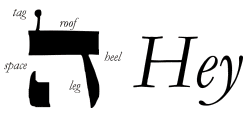|
|
 |
|
|
 |
 |
 |
|
The letter Hey is the fifth letter of the Aleph-Bet, having the numeric value of five. The pictograph for Hey looks like a man with his arms raised, whereas the classical Hebrew script (ketav Ashurit) is constructed of two Vavs (of the Dalet) with an unattached and inverted Yod that functions as the "foot" of the letter. The meaning of the name "Hey" is "look," or "behold!"
- The Mystery of Hey
According to the Jewish mystics, Hey represents the divine breath, revelation, and light (the word "light" is mentioned five times on the first day of creation (Gen. 1:3-4), which is said to correspond to the letter Hey). Since the numerical value of Hey is five, this corresponds on a physical level to the five fingers, the five senses, and the five dimensions. On a spiritual level it corresponds to the five levels of soul:
- Nefesh - instincts
- Ruach - emotions
- Neshamah - mind
- Chayah - bridge to transcendence
- Yechidah - oneness
- Hey represents God's Creative Power
"By the word of the LORD were the heavens made; and all the host of them by the breath of his mouth" (Psalm 33:6). In the Talmud (Menachot 29b) it is said that the "breath of His mouth" refers to the sound of the letter Hey - the outbreathing of Spirit.
Moreover, in the fifth word of Genesis 2:4, the hey appears smaller than usual:

This could be seen as "in Hey" they (i.e., the heavens and the earth) were created. Moreover, since Bet represents the Son of God (the Word of the LORD), we could read this as the Son breathed forth creation.
- Hey and the Divine Name
The Sacred Name,  , includes two instances of the letter Hey. , includes two instances of the letter Hey.
- Hey and the Divine Presence
According to one midrash, Yod left Aleph to become part of Dalet, thus forming Hey. Since Aleph represents God and Dalet represents broken humanity, Hey is a picture of the presence of God within the human heart. This function of Hey can be seen when  (Abram) was renamed to (Abram) was renamed to  (Abraham) and (Abraham) and  (Sarai) was renamed to (Sarai) was renamed to  (Sarah). (Sarah).
- Prefixive Hey
Hey functions as the definite article in Hebrew, a sort of demonstrative that points to the object and makes it concrete and definite. Thus  (ish), a man, becomes (ish), a man, becomes  (ha-ish), the man. (ha-ish), the man.
- Suffixive Hey
Adding a Hey at the end of a noun "feminizes" it or allows it to be "fruitful" and reproductive.
- Hey and Teshuvah
Since Hey is formed from Dalet and Yod, it can also be a picture of returning to God by means of the transforming power of the Spirit. Dalet stands for brokenness, and Yod stands for a hand. Opening the door of the heart then is a picture of the Spirit of God indwelling the believer, and this image also coheres with the idea that part of Aleph (God) is joined with Dalet to form the Hey.
|
|











